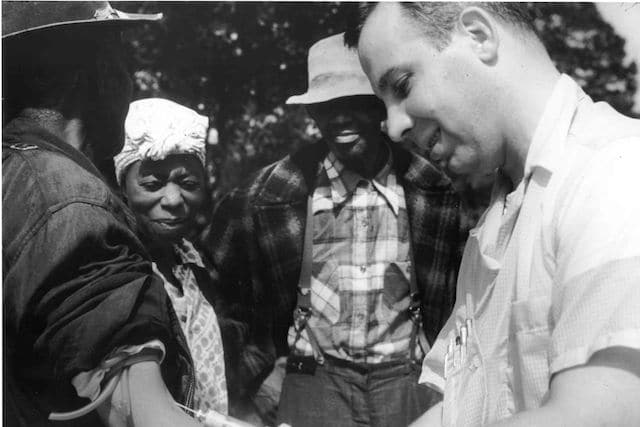When’s the last time you heard of any good human experimentation? It’s probably been a while. Human experimentation is often grim, grisly and downright terrifying. Sometimes it’s physically harrowing while other times it’s psychologically scarring. Some of the worst examples have proven that mankind has a boundless creativity when it comes to subjecting our own kind to terrible things. Let’s take a look at some of the worst of the worst.
10. Freud and Emma Eckstein

You’ll be hard pressed these days to find a lot of people who think Sigmund Freud was 100% on the ball in terms of his medical opinions and that doesn’t even get into his cocaine use. This story does get into his cocaine use, though.
In 1895, Freud had a patient named Emma Eckstein who was suffering menstrual cramps and depression related to that. In modern times that’s a pretty common issue we can wrap our heads around and understand. In 195, Freud decided she had hysteria and was masturbating too much. His solution? Cauterize her nose.
Freud was at the peak of his cocaine addiction at this time and felt it was inspiring him to flesh out his ideas. He felt the nose, and the genitals were linked so burning the inside of his patient’s nose would destroy what he felt was her overactive sex drive. Remember, this woman had depression and cramps. But he didn’t use heat to cauterize her nose, he used cocaine.
Freud, with the help of another doctor, packed Eckstein’s nose with the drug until it seared into her sinuses, cauterized the inside of her head, then sealed the bloody mess shut. When she came back two weeks later complaining of nose bleeds, another doctor unpacked her gauze and sponges that had been left in her head and she bled out so much she literally passed out on the spot.
Eckstein nearly died, her heart stopped briefly, and for days she bled and bled. How did Freud respond? He had a dream that he translated into his book “Irma’s Injection” about what a great doctor he was.
9. Henrietta Lacks and the Immortal Cells

Modern medicine owes a debt of gratitude to Henrietta Lacks. You may never heard of her but she’s a big part of the reason you’re not likely to get polio anytime soon, not to mention her contributions to gene mapping and research into in vitro fertilization. Sadly, that doesn’t mean she was a groundbreaking scientist or researcher. It means she was exploited by those people.
HeLa cells are what they call “immortal” cells, a strain of human cells that can be grown indefinitely in a lab setting to be researched and used to learn and better our medical understanding of all kinds of things. They get shared and frozen sometimes for years at a time. HeLa cells were the first cells like this ever created. They were used to develop the polio vaccine. Experiments in cloning have been conducted with them. They even got shot right into space. And they came from an unknown donor with cervical cancer back in the 1950s. Only the thing was she wasn’t unknown, she was Henrietta Lacks. And she wasn’t a donor.
Doctors at John Hopkins took Henrietta’s cells without informing her. After Henrietta died, her family had no idea the legacy that she had left behind, including the fact that her cells were at the center of an industry worth billions of which Henrietta and her family saw nothing thanks to doctors using her genetic material without her consent or much care for the fact she’d been a real person.
8. William Beaumont and the Gut Hole

Army surgeon William Beaumont was a curious man with a curious set of circumstances. In 1822, he treated the victim of a shotgun blast to the stomach at close range. The hole is the size of a fist, the victim’s lung is hanging out, and his stomach tore open enough that his breakfast fell out. Prognosis? Not so good. And yet somehow Beaumont kept this man alive, even feeding him through rectal injections for two straight weeks since food couldn’t go in the traditional way.
After months of care, the victim has inexplicably begun to heal, but the problem is the hole in his stomach isn’t closing, his body is just healing around it. So Beaumont is in the unusual position of having a patient with a fistula, an open window to his guts. And he decided to play around with it.
Beaumont starts putting food in the man’s stomach and then taking it out again to look at it. He tied meat on a string and dangled it inside like he was fishing for guts. For years Beaumont played with this poor man’s stomach hole and it helped establish much of the modern understanding of the techniques by which digestion works. On the other hand, Beaumont treated his patient like crap, frequently referring to him in writing as a drunkard and a villain.
Over the course of their relationship, Beaumont would jam all kinds of things in his patient’s gut that left him feeling woozy or ill. This went on for a decade.
7. Mustard Gas Tests

Mustard gas, or sulfur mustard, was used in chemical warfare starting in the First World War. Get it on your skin and it causes blisters. Get exposed to enough and you will die. How do we know that? The US government tested it on our own soldiers.
Around 60,000 soldiers were exposed to chemical warfare agents by their own government in experiments to see how they worked and what they did to the human body. Troops were ordered to just sit in sealed rooms as chemicals were pumped in. Some passed out, some were burned, all did as they were told because that’s what good soldiers do.
Some soldiers were chosen specifically because they were black so researchers could see what the chemicals did to darker skin. Japanese-Americans and Puerto Ricans were chosen to see what the chemicals would do to Japanese enemies. Their reactions were compared to “normal” reactions which were what the reactions of white soldiers were considered. Somehow they’d managed to mix horrible torture and racism in the same experiment.
6. J. Marion Sims

They call J. Marion Sims the Father of Modern Gynecology. If ethics were a concern, he wouldn’t have that title, though. All of the research and understanding he was able to bring to medicine regarding women’s reproductive health including the invention of the speculum and a surgery to repair painful fistulas caused during birth was a result of experiments on slaves, often conducted with no anesthetic or consent.
A slave owner himself, the women Sims experimented on were considered property at the time and could not consent to any procedures. In addition, he believed that black women were incapable of feeling pain and as a result used no anesthesia for his surgeries. In his autobiography he bragged about how great it was that, owning these patients as property, he was free to experiment on them any time of day that he wanted because they couldn’t refuse.
5. Vanderbilt Radiation Study

The dietary concerns of pregnant women is still an issue today and it’s a valid field to research. In 1946, Vanderbilt University decided to study this with a twist, giving 751 women doses of radioactive iron and studying the effects on them and their unborn children. The exposure was about 30 times higher than natural exposure levels. The point was just to study iron absorption levels.
A follow-up study in the 1960s shows that three children in the study had died from cancer likely caused by the exposure when they were in utero.
4. Guatemala Syphilis Experiment

You may have heard of the Tuskegee Syphilis experiments but they were not the only ones. In 1946, thousands of Guatemalans were infected with syphilis and gonorrhea without their consent so that drug treatments for the illness could be tested for their efficacy to help soldiers in wartime who contracted STDs from sex workers.
Subjects included psychiatric patients, sex workers, soldiers, and children as young as one year old.
3. University of Washington Reproductive Radiation Test

When you go to the dentist they’ll drape you in a big, lead vest before you get a mouth X-ray. That’s because radiation is no joke, despite how this story about men having their testicles deluged with radiation might sound.
In the early 1960s, prisoners were enticed to volunteer for an experiment with promises of early parole and money. All they had to do was let researchers bombard their testicles with radiation. Over 100 men sat for the equivalent of hundreds of X-rays dosed out in 10 minute exposures. One participant was told he was being exposed to 400 rads. Two-hundred rads in a day can cause acute radiation sickness.
Years later a class action lawsuit won the prisoners a $2.4 million settlement as many suffered skin lesions and cancer as a result of the experiment.
2. David Reimer
The story of Bruce Reimer is tragedy heaped on tragedy. In 1965, in what should have been a routine circumcision at the hospital, the equipment malfunctioned and 7-month-old Bruce’s entire penis was burned off. The desperate family turned to Dr. John Money, a man who claimed to be a pioneer in sex-change. Money suggested that Bruce, now 18-months-old, should be raised as a girl.
Bruce is surgically castrated and a vulva is constructed from the remaining tissue. The family calls their child Brenda. Money tells them that, if it happens before the age of two, the child’s gender can easily be changed and it’s just a matter of how the child is raised, not physical characteristics.
Brenda grows up acting like a boy, wanting to do traditional boy things. And she hates Dr. Money who constantly talks to her about her genitals and takes pictures of her and her brother naked, then shows her videos of women giving birth to try to convince her to have a “baby hole” surgically constructed.
At age 13, the family tells Brenda and her twin brother the truth. Brenda, relieved, immediately decides to become a boy again and names himself David. But the damage is done. His brother Brian never gets over the emotional trauma of growing up as they did and dies of a drug overdose. David struggles through life but loses his job, his wife, and at age 38 he takes his own life.
As for Dr. Money? He said he was blameless because the family waited too long to reassign gender and David refused to accept his female identity.
1. Unit 731

Few things in history inspire disgust more than stories of Unit 731, the Japanese Army’s diabolical lab that conducted some of the most perverse and terrifying experiments in human history.
Originally devised as a way to help prevent and treat infections in soldiers, Unit 731 infected subjects with anthrax, cholera, the plague, and more. Organs were removed for study while patients were still living. Treatments were withheld so a disease could be observed as it ran its full course.
In addition to disease, human endurance was tested. Subjects were drained of blood to see how much they could live without. Others were frozen to see how frostbite worked. Some were deprived of water to see how long it would take dehydration to kill.
Subjects ranged from prisoners to the mentally ill to children. Limbs were removed from conscious patients to see how long it would take for blood loss to knock them out. Sometimes they were reattached but not from where they had been removed. Grenades and flamethrowers were also tested on subjects, a nightmare of every awful and painful thing a human can endure was done. And the perpetrators? They shared the information they had learned as part of a deal to escape prosecution.